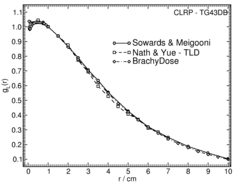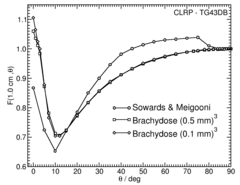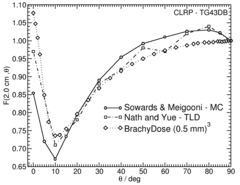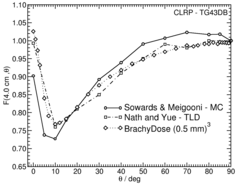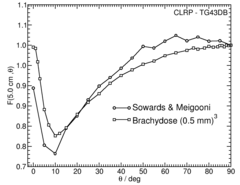

Source Description:
Dimensions for the Best 2301 source 1,2,3 are taken from the study by Sowards and Meigooni. The 2301 source consists of a cylindrical tungsten marker 3.75 mm long with a diameter of 0.250 mm. In this study the ends of the marker are assumed to be round as shown in the figure in TG-43U1. The marker is coated with an organic matrix (assumed to be polystyrene with a density of 1.06 g/cm 3 and a composition by weight of 7.74% H and 92.3% C) containing 125 I. For the purpose of these calculations the amount of 125 I present in the polystyrene is assumed to be negligible. The thickness of the coating is assumed to be 0.100 mm on the cylindrical surface as well as the round ends. The active element is encapsulated in a 0.080 mm thick titanium casing with an outer diameter of 0.800 mm. The end welds are assumed to be hemi-spherical shells with a thickness of 0.080 mm. The overall source length is 5.00 mm and the active length is 3.95 mm. The cylindrical source element is free to move approximately 0.445 mm along the seed axis and 0.095 mm radially from the center of the seed.Dose Rate Constant - Λ :
Dose rate constants, Λ , are calculated by dividing the dose to water per history in a (0.1 mm) 3 voxel centered on the reference position, (1 cm,Π/2), in the 30x30x30 cm 3 water phantom, by the air kerma strength per history (scored in vacuo ). As described in ref. 4 , dose rate constants are provided for air kerma strenth calculated using voxels of 2.7x2.7x0.05 cm 3 (WAFAC) and 0.1x0.1x0.05 cm 3 (point) located 10 cm from the source. The larger voxel size averages the air kerma per history over a region covering roughly the same solid angle subtended by the primary collimator of the WAFAC 5,6 at NIST used for calibrating low-energy brachytherapy sources and is likely the most clinically relevant value. The small voxel serves to estimate the air kerma per history at a point on the transverse axis.
| Author | Method | Λ (cGy h-1 U-1) | Abs. Uncertainty |
| R. E. P. Taylor, D. W. O. Rogers 7 | WAFAC | 0.998 | 0.002 |
| R. E. P. Taylor, D. W. O. Rogers 7 | point | 1.002 | 0.003 |
| K. Sowards, A. S. Meigooni 1 | point (PTRAN) | 1.01 | 0.03 |
| A. S. Meigooni et al 2 | TLD | 1.01 | 0.08 |
| R. Nath, N. Yue 3 | TLD | 1.02 | 0.07 |
| M. J. Rivard et al 8 | Consensus Value | 1.018 |
Radial dose function - g(r):
The radial dose function, g(r), is calculated using both line and point source geometry functions and tabulated at 36 different radial distances ranging from 0.05 cm to 10 cm. Fit parameters for a modified polynomial expression are also provided 9 .
| Fitting coefficients for g L (r) = (a 0 r -2 + a 1 r -1 +a 2 + a 3 r +a 4 r 2 + a 5 r 3 ) e -a 6 r | ||||||||
| Fit range | Coefficients | |||||||
| r min (cm) | r max (cm) | a 0 / cm 2 | a 1 / cm | a 2 | a 3 / cm -1 | a 4 / cm -2 | a 5 / cm -3 | a 6 / cm -1 |
| 0.05 | 10.00 | 6.4235E-04 | -1.4342E-02 | 1.0594E+00 | 4.8553E-01 | -1.0204E-02 | 1.6721E-03 | 4.2050E-01 |
Anisotropy function - F(r,θ):
Anisotropy functions are calculated using the line source approximation and tabulated at radii of 0.1, 0.15, 0.25, 0.5, 0.75, 1, 2, 3, 4, 5, 7.5 and 10 cm and 32 unique polar angles with a minimum resolution of 5 o . The anisotropy factor, φ an (r), was calculated by integrating the solid angle weighted dose rate over 0 o ≤ ϑ ≤ 90 o .
References:
1. K. Sowards, A. S. Meigooni, A Monte Carlo evaluation of the dosimetric characteristics of the Best Model 2301 125 I brachytherapy source, Brachytherapy} pages, 57 , , 2002
2. A. S. Meigooni et al , Experimental determination of dosimetric characteristics of Best 125 I brachytherapy source, Med. Phys., 27 , 2168--2173, 2000
3. R. Nath, N. Yue, Dosimetric characterization of an encapsulated interstitial brachytherapy source of 125 I on a tungsten substrate, Brachytherapy, 1 , 102--109, 2002
4. R. E. P. Taylor et al , Benchmarking BrachyDose: voxel-based EGSnrc Monte Carlo calculations of TG--43 dosimetry parameters, Med. Phys., 34 , 445 -- 457, 2007
5. R. Loevinger, Wide-angle free-air chamber for calibration of low--energy brachytherapy sources, Med. Phys., 20 , 907, 1993
6. S. M Seltzer et al , New National Air-Kerma-Strength Standards for 125 I and 103 Pd Brachytherapy Seeds, J. Res. Natl. Inst. Stand. Technol., 108 , 337 -- 358, 2003
7. R. E. P. Taylor, D. W. O. Rogers, An EGSnrc Monte Carlo-calculated database of TG-43 parameters, Med. Phys., 35 , 4228--4241, 2008
8. M. J. Rivard et al , Update of AAPM Task Group No. 43 Report: A revised AAPM protocol for brachytherapy dose calculations, Med. Phys., 31 , 633 -- 674, 2004
9. R. E. P. Taylor, D. W. O. Rogers, More accurate fitting of 125 I and 103 Pd radial dose functions, Med. Phys., 35 , 4242--4250, 2008
Carleton Laboratory for Radiotherapy Physics
December 17 2007.
